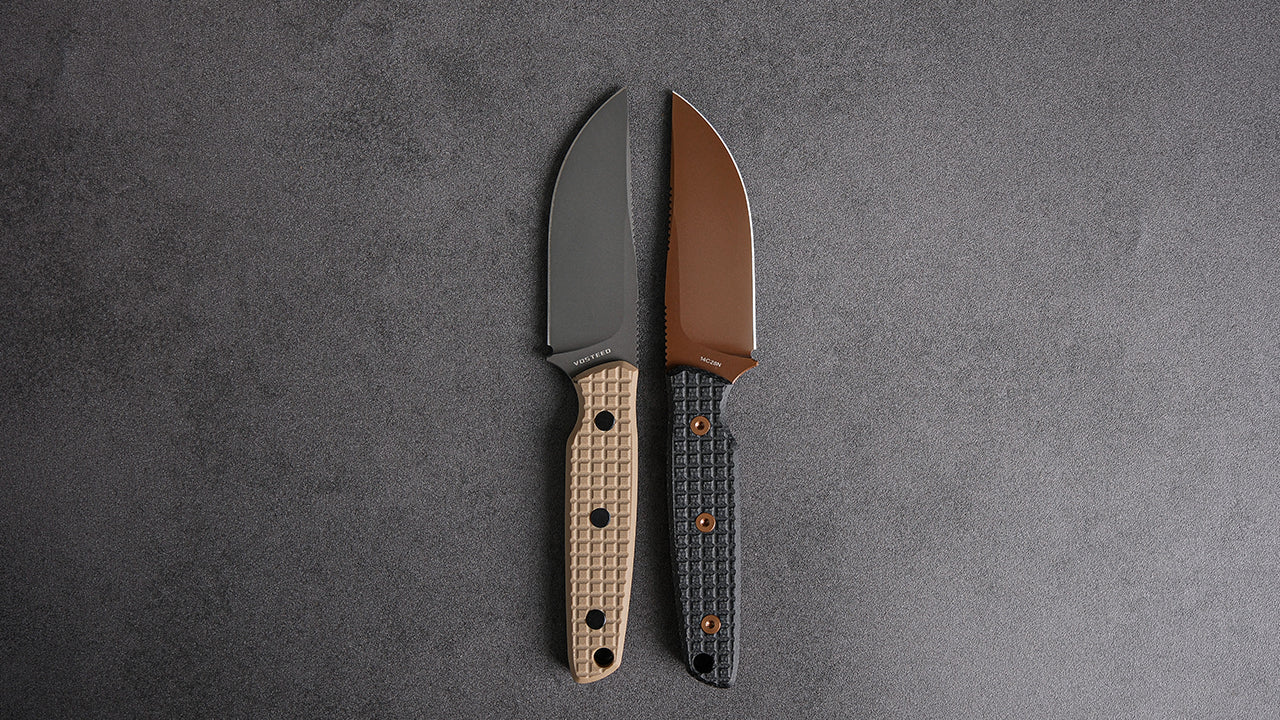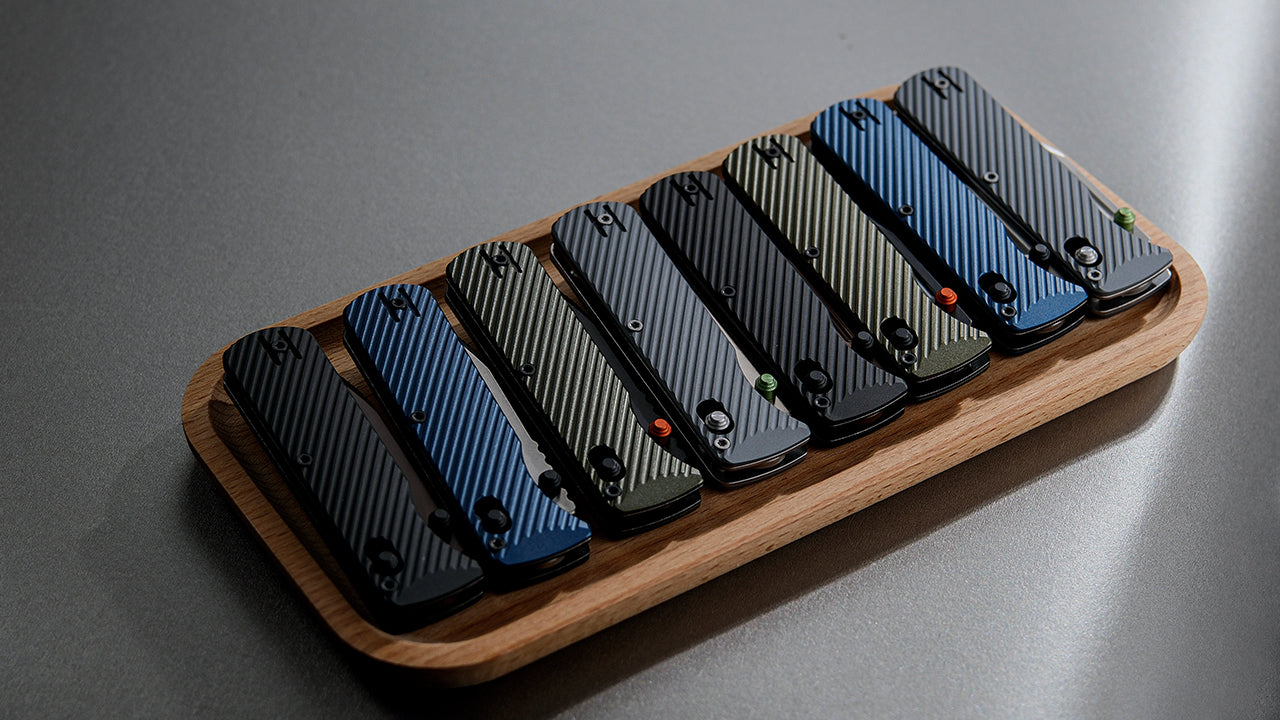Knives and daggers have long stood as two of mankind’s most enduring and functional edged tools. Although they seem like they're identical at first glance—both having sharpened blades and meant to cut—they have very different functions and are constructed with different intentions.
Whether you're selecting a knife for outdoor survival, personal defense, or EDC, understanding the distinction between a knife and a dagger can assist you in making a more informed choice. Throughout this guide, we cover their design, purpose, and history, while giving modern analysis for today's knife collectors.

Key Design Differences Between Knives and Daggers
Technically, knives and daggers vary most at a fundamental level with regard to blade geometry and edge structure.
Blade Shape and Edge
- Knife: Typically features a single-edged blade, best adapted to cutting and utility functions. The spine—the unsharpened side—provides structural strength and a surface for thumb pressure. Common knife blade shapes include drop point, clip point, sheepsfoot, and tanto.
- Dagger: Characterized by a double-edged, symmetrical blade to be used for thrust or piercing. The edges are usually tapered into a sharp point in a spear-like fashion, with not much regard given to slicing potential.
Handle and Guard
- Knife handles are wildly diverse based on their proposed application—some are designed with ergonomics in mind for long-term use, while others have finger grooves for accuracy-based applications.
- Daggers have a cross-guard to protect the hand during thrusting. It is not quite common in utility knives.
Blade Thickness
- Knives blade thickness varies depending on the intended use—thicker blades for heavy-duty tasks, thinner for precision work.
- Daggers generally have a median ridge and even grind, offering stiffness to push through but diminishing slicing effectiveness.
Balance and Symmetry
- Most knives are asymmetrical in design, with a spine along one side and an edge on the other side. This assists in control and leverage when cutting at objects.
- Daggers are more symmetrical about the centerline, so they are more suitable for penetrating straight into a target with even pressure from both sides of the blade.
Functional Differences: Knives vs Daggers
Utility and Everyday Tasks
Knives are highly versatile and can be utilized for a variety of purposes such as preparing food, cutting ropes, carving, and survival purposes. Compact EDC knives like Vosteed’s Raccoon or Bellamy offer exceptional utility without bulk.
Daggers, however, are practical tools traditionally employed for close combat and personal defense. Being double-edged, they become less convenient—and even hazardous—to use on a day-to-day basis since they lack a safe gripping area for doing precision tasks.
Self-Defense and Tactical Use
While daggers have been favored for close fighting throughout history, the majority of modern fixed blade self-defense knives are made with hybrid profiles that maintain stabbing ability without sacrificing utility. Some examples are blade styles like the tanto or reverse tanto.
Double-edged blades, as stated in U.S. Army field manuals, are specifically designed for penetration in combat situations but are lacking for everyday use.

Historical and Cultural Significance
Knives and daggers have divergent and rich histories.
- Knives date back over 2.5 million years and are among the earliest tools created by humans. They've evolved from stone flakes to modern high-performance tools used across every industry—from culinary arts to rescue operations.
- Daggers, nevertheless, have long also been symbolic and ceremonial alongside practical. Egyptian, Roman, and medieval European cultures all employed daggers for use in battle as well as religious rituals. Most often, the dagger was synonymous with honor, betrayal, or nobility.
Examples that ring a bell include the Roman pugio, the Scottish Highlanders' dirk, and thec—each of which enjoyed unique designs and connotations among cultures.
Tips on Maintenance and Safety
Sharpening
- Knives require frequent sharpening with a whetstone, guided system, or pull-through sharpener. A 20° angle on both sides is standard for general-use knives.
- Daggers, having double edges, require sharpening on both sides symmetrically, which is more laborious and tricky.
Storage
- Knives are usually kept in sheaths, pockets, or knife blocks. For folding knives, locking mechanisms within have to be maintained clean and oiled. Regular cleaning and proper disassembly of folding knives prevents debris buildup.
- Daggers, as tipped and symmetrical-bladed knives, require rigid sheaths so that they may not accidentally cut or blunt during handling.
*Safety Note:
Owing to their aggressive design, daggers are never to be used in minor or utility-oriented applications where slippage by hand or being overpowered could lead to serious injury.
Choosing a Knife or a Dagger
Priorities of Top Importance (Usage, Environment, Legality)
- Purpose: If you need a general-purpose cutting tool to carry outside or with you every day, a knife is the clear answer. For ceremonial, self-protection, or collector purposes, a dagger can be appropriate.
- Environment: Urban and everyday environments permit folding or small fixed blade knives. Daggers are likely to provoke unwanted attention or suspicion.
- Legalities: In most jurisdictions, daggers and double-edged blades are prohibited or entirely illegal. Always check local law before purchasing or carrying one.
*KnifeRights.org provides updated legal summaries for most U.S. states.
Pros and Cons of Knives vs Daggers
| Feature | Knife | Dagger |
| Versatility | High | Low |
| Legal Carry | Generally permitted | Often restricted |
| Ease of Maintenance | Easier (one edge) | More complex (two edges) |
| Historical Utility | Everyday tasks, survival | Primarily combat and defense |
| Safety in Use | Safer for cutting, grip support | Risk of hand slippage during slicing |
Recommendations by Specific Use Case
- Everyday Carry (EDC): Choose a folding or fixed blade knife like the Vosteed Raccoon, Bellamy, or Nightshade.
- Outdoor Survival: A drop point or sheepsfoot blade fixed blade knife is a good option.
- Martial Arts / Tactical Display: Daggers are permitted in some jurisdictions and can be employed for ceremonial or training use, but they are not frequently recommended for EDC.
- Collectors: Exotic, high-end daggers of historical or artistic interest are great additions to any collection.

FAQs About Knives and Daggers
Q1: Can a Dagger Be Used as a Knife?
Technically, yes, but not effectively or safely. Daggers are not as suited to slicing or utility work, and the double edge increases the danger. For any useful purpose, a knife is a more efficient and safer weapon.
Q2: Are Daggers Legal to Own?
Laws vary greatly. In many U.S. states, possession is legal but transportation is illegal. In a few, double-edged blades are illegal to own outright. Always check state and local laws before purchasing or transporting a dagger.
Q3: What's the Optimal Blade Material for Knives and Daggers?
For daggers, prioritize hardness, tip strength, and corrosion resistance—materials like CPM S35VN, developed by Crucible Industries, are ideal for maintaining a strong point and edge integrity.
For knives, balance is key. Steels like 14C28N offer excellent corrosion resistance, sharpenability, and edge retention for daily use. D2 is another strong choice for tough cutting tasks, though it requires more care to prevent rust.
Q4: Are double-edged blades necessarily daggers?
Not necessarily. Most double-edged blades fall in the category of daggers, but there exist tools like special combat knives or bayonets that have qualities without being legally categorized as daggers. Again, legality would largely depend upon neighborhood definitions and laws.
Q5: Is a dagger fit for regular use as a knife?
While technically feasible, using a dagger for everyday tasks is neither practical nor advisable. Practical tasks like cutting food, opening boxes, or cutting ropes require control and stability of the blade that daggers typically cannot offer. A well-designed utility knife is always better for daily tasks.
Final Thoughts
Where knives and daggers may seem similar at first glance, their function, purpose, and legality are quite different. Knives are utility tools for work, survival, and everyday carry, whereas daggers are specialized knives with historical, martial, or ceremonial meanings.
A quality fixed-blade or folder from a reputable company like Vosteed is a superior value, safer, and more law-abiding for the typical user's requirements, especially one in need of an effective workaday tool.





Leave a comment
All comments are moderated before being published.
This site is protected by hCaptcha and the hCaptcha Privacy Policy and Terms of Service apply.